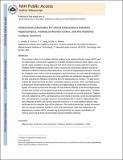| dc.contributor.author | Varela, Carmen | |
| dc.contributor.author | Kumar, S. | |
| dc.contributor.author | Yang, J. Y. | |
| dc.contributor.author | Wilson, Matthew A. | |
| dc.date.accessioned | 2016-05-25T18:07:38Z | |
| dc.date.available | 2016-05-25T18:07:38Z | |
| dc.date.issued | 2016-05-25 | |
| dc.date.issued | 2013-04 | |
| dc.identifier.issn | 1863-2653 | en_US |
| dc.identifier.issn | 1863-2661 | en_US |
| dc.identifier.uri | http://hdl.handle.net/1721.1/102682 | |
| dc.description.abstract | The reuniens nucleus in the midline thalamus projects to the medial prefrontal cortex (mPFC) and the hippocampus, and has been suggested to modulate interactions between these regions, such as spindle–ripple correlations during sleep and theta band coherence during exploratory behavior. Feedback from the hippocampus to the nucleus reuniens has received less attention but has the potential to influence thalamocortical networks as a function of hippocampal activation. We used the retrograde tracer cholera toxin B conjugated to two fluorophores to study thalamic projections to the dorsal and ventral hippocampus and to the prelimbic and infralimbic subregions of mPFC. We also examined the feedback connections from the hippocampus to reuniens. The goal was to evaluate the anatomical basis for direct coordination between reuniens, mPFC, and hippocampus by looking for double-labeled cells in reuniens and hippocampus. In confirmation of previous reports, the nucleus reuniens was the origin of most thalamic afferents to the dorsal hippocampus, whereas both reuniens and the lateral dorsal nucleus projected to ventral hippocampus. Feedback from hippocampus to reuniens originated primarily in the dorsal and ventral subiculum. Thalamic cells with collaterals to mPFC and hippocampus were found in reuniens, across its anteroposterior axis, and represented, on average, about 8 % of the labeled cells in reuniens. Hippocampal cells with collaterals to mPFC and reuniens were less common (~1 % of the labeled subicular cells), and located in the molecular layer of the subiculum. The results indicate that a subset of reuniens cells can directly coordinate activity in mPFC and hippocampus. Cells with collaterals in the hippocampus–reuniens–mPFC network may be important for the systems consolidation of memory traces and for theta synchronization during exploratory behavior. | |
| dc.description.sponsorship | National Institutes of Health (U.S.) (grant 5R01MH061976) | |
| dc.description.sponsorship | Caja Madrid Foundation (Fellowship) | |
| dc.language.iso | en_US | |
| dc.publisher | Springer-Verlag | |
| dc.relation.isversionof | http://dx.doi.org/10.1007/s00429-013-0543-5 | en_US |
| dc.rights | Creative Commons Attribution-Noncommercial-Share Alike | en_US |
| dc.rights.uri | http://creativecommons.org/licenses/by-nc-sa/4.0/ | en_US |
| dc.source | PMC | en_US |
| dc.title | Anatomical substrates for direct interactions between hippocampus, medial prefrontal cortex, and the thalamic nucleus reuniens | en_US |
| dc.type | Article | en_US |
| dc.identifier.citation | Varela, C., S. Kumar, J. Y. Yang, and M. A. Wilson. “Anatomical Substrates for Direct Interactions Between Hippocampus, Medial Prefrontal Cortex, and the Thalamic Nucleus Reuniens.” Brain Struct Funct 219, no. 3 (April 10, 2013): 911–929. | en_US |
| dc.contributor.department | Massachusetts Institute of Technology. Department of Brain and Cognitive Sciences | |
| dc.contributor.department | Picower Institute for Learning and Memory | |
| dc.contributor.mitauthor | Varela, Carmen | |
| dc.contributor.mitauthor | Kumar, S. | |
| dc.contributor.mitauthor | Yang, J. Y. | |
| dc.contributor.mitauthor | Wilson, Matthew A. | |
| dc.relation.journal | Brain Structure and Function | en_US |
| dc.eprint.version | Author's final manuscript | en_US |
| dc.type.uri | http://purl.org/eprint/type/JournalArticle | en_US |
| eprint.status | http://purl.org/eprint/status/PeerReviewed | en_US |
| dspace.orderedauthors | Varela, C.; Kumar, S.; Yang, J. Y.; Wilson, M. A. | en_US |
| dspace.embargo.terms | N | en_US |
| dc.identifier.orcid | https://orcid.org/0000-0001-7149-3584 | |
| mit.license | OPEN_ACCESS_POLICY | en_US |
| mit.metadata.status | Complete | |
